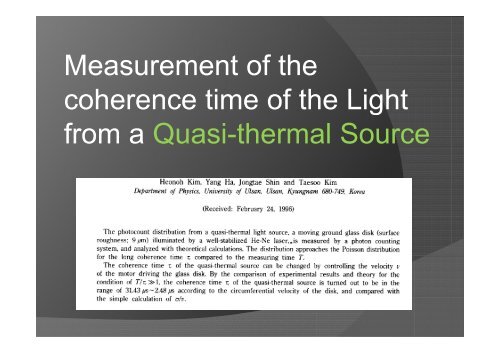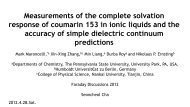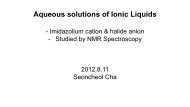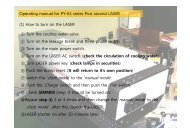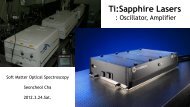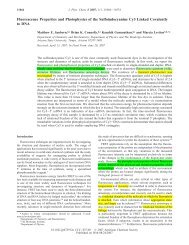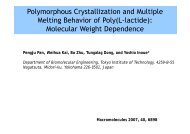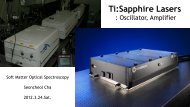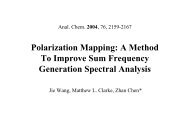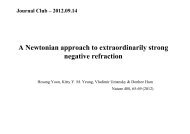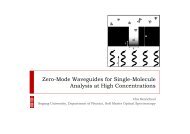Measurement of the coherence time of the Light from a Quasi ...
Measurement of the coherence time of the Light from a Quasi ...
Measurement of the coherence time of the Light from a Quasi ...
You also want an ePaper? Increase the reach of your titles
YUMPU automatically turns print PDFs into web optimized ePapers that Google loves.
M<strong>Measurement</strong> t <strong>of</strong> f <strong>the</strong> th<br />
<strong>coherence</strong> <strong>time</strong> <strong>of</strong> <strong>the</strong> <strong>Light</strong><br />
<strong>from</strong> a <strong>Quasi</strong>-<strong>the</strong>rmal Source
Chaotic light<br />
(<strong>the</strong>rmal cavity, filament lamp)<br />
The different atoms are excited by an<br />
electrical discharge and emit <strong>the</strong>ir radiation<br />
independently <strong>of</strong> one ano<strong>the</strong>r.<br />
The shape <strong>of</strong> an emission line is determined<br />
by <strong>the</strong> statistical spread in atomic velocities<br />
and <strong>the</strong> random occurrence <strong>of</strong> collisions.<br />
Δ Δνν <br />
1<br />
Generally,<br />
Δ Δνν = − 12 ττ c <br />
τ<br />
τ c ≤<br />
10 s<br />
c
collision τ2 collision τ1 collision<br />
Lorentzian<br />
lineshape<br />
collision-broadened lli i b d d li light h source<br />
Gaussian<br />
lineshape<br />
Doppler broadening light source
Used rotating ground glass disk<br />
(surface roughness: 9㎛)<br />
Q<strong>Quasi</strong>-<strong>the</strong>rmal i th l SSource<br />
It has property <strong>of</strong> chaos light, but<br />
<strong>coherence</strong> <strong>time</strong> is longer than<br />
chaos light. g<br />
τc <strong>of</strong> <strong>the</strong> quasi-<strong>the</strong>rmal source<br />
can be changed by controlling<br />
<strong>the</strong> velocity y v <strong>of</strong> <strong>the</strong> motor driving g<br />
<strong>the</strong> glass disk.<br />
τ =<br />
c<br />
σ σ (surface ( roughness) g )<br />
v<br />
(rotating speed)
I (, tT) is <strong>the</strong> mean intensity that falls on <strong>the</strong> phototube during<br />
<strong>the</strong> period <strong>from</strong> t to t+T, <strong>the</strong>n,<br />
1 t+ T<br />
I ( t t, T ) = ∫ I ( t ) dt dt′<br />
T ∫t<br />
The probability <strong>of</strong> detecting n number <strong>of</strong> photons during <strong>time</strong> duration<br />
T is<br />
P ( T ) = P ( t, T )<br />
n n<br />
n<br />
⎡⎣⎡ζζI (, t T ) T⎤⎦⎤<br />
=<br />
⎣ ⎦<br />
exp ⎡ ⎡ζI( t, T) T ⎤<br />
n!<br />
⎣ ⎦<br />
This result is Known as <strong>the</strong> Mandel formula. ζ<br />
(efficiency <strong>of</strong> detector)
So Mean number <strong>of</strong> photocounts is<br />
∞<br />
∑<br />
= 0<br />
n = nPP ( T ) = ζζ I ( t, TT T) ) T = ζζIT<br />
IT<br />
n<br />
n<br />
And <strong>the</strong> second moment <strong>of</strong> <strong>the</strong> distribution given by<br />
∞<br />
2 2<br />
n ∑ ∑nPT<br />
n ( ) ζζI ( tTT , ) ζζI(<br />
( tTT , )<br />
n=<br />
0<br />
= = + ⎡ ⎣ ⎤ ⎦<br />
= n + ⎣⎡ζI(, t T) T⎦⎤<br />
2<br />
The variance <strong>of</strong> <strong>the</strong> photocount distribution is <strong>the</strong>refore<br />
2 2 2<br />
2 2 ( ) ( 2 2<br />
Δ n = n − n = n + ζ T I(, t T) −I<br />
)<br />
2
Line width γ(1/ τ )<br />
= Lorentzian lineshape function<br />
Its second order <strong>coherence</strong> function is, is<br />
(2) −2γ<br />
τ<br />
g ( τ ) = 1+<br />
e<br />
The average <strong>of</strong> integration <strong>time</strong> T is<br />
c<br />
T T<br />
1<br />
∫∫<br />
−2γγ t −t<br />
− = ∫∫ 2<br />
1 2<br />
T<br />
2<br />
(2) ( )<br />
2 1<br />
g (0) 1 e dtdt<br />
0 0<br />
1 −2γT<br />
= ⎡e + 2γT −1⎤<br />
2 2<br />
2γ<br />
T ⎣ ⎦<br />
g<br />
(2)<br />
(0)<br />
=<br />
I(, t T)<br />
I<br />
2
( )<br />
2<br />
2 n −2γT<br />
Δ n = n + ⎡e + 2γT −1⎤<br />
2 2<br />
2 2γγ T ⎣ ⎦<br />
T > τ c<br />
T ττ<br />
c<br />
( )<br />
2<br />
Δ n = n + n<br />
( ) 2 n<br />
n n<br />
2<br />
2<br />
T τ c<br />
Δ = + ( )<br />
γT<br />
2<br />
Δ n =<br />
n
<strong>Measurement</strong> <strong>time</strong> : T Redline: pulse<br />
T T T T T T T T T T<br />
0 1 2 3 4 5 6 7 8 9 10<br />
Photocount<br />
10,000 <strong>time</strong>s<br />
t
<strong>Measurement</strong> <strong>time</strong> : T (fixed: 10 μs) =4<br />
Voltage change (velocity <strong>of</strong> <strong>the</strong> motor driving) :<br />
τc change
Variance <strong>of</strong> ( ) by <strong>the</strong> velocity v<br />
2<br />
Variance <strong>of</strong> ( Δ n n)<br />
by <strong>the</strong> velocity v<br />
v (rotating speed) (m/s)
T=50 T 50 μs<br />
T=30 μs<br />
T=20 μs<br />
τ<br />
c<br />
σ( = 9 μm)<br />
v<br />
= ( )<br />
2 τ c n<br />
Δ n = n +<br />
T<br />
2


